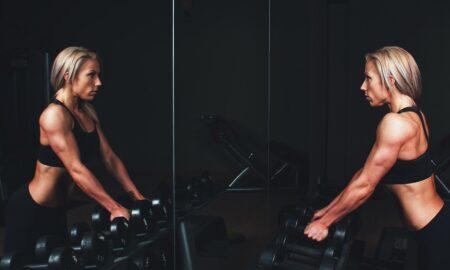Q: I live in a small apartment and have only a flat-to-incline bench, including a Scott bench attachment, and an adjustable dumbbell set. What is your favorite dumbbell exercise for the biceps?
A: I wrote two books on arm training, and you want just one exercise for the elbow flexors? As a compromise, how about I give you three great dumbbell exercises, each made popular by a bodybuilder who had a considerable influence on the evolution of bodybuilding as a sport.
Incline dumbbell curl. This exercise was popularized by the late Steve Reeves, who won the AAU Mr. America in 1947 and won the first NABBA Mr. Universe in 1950. He became a household name through his appearance as Hercules in the 1959 movie “Hercules Unchained.” The inclined position of the bench permits the elbows to be drawn back, away from the body, making it one of the most effective exercises for isolating the long head of the biceps.
Recline on a multiangle bench with a dumbbell in each hand. The more flexible you are, the lower you can set the bench, but bringing it down to a flat position may be too hard on your rotator cuff muscles. As a rule of thumb, the lower the angle of the bench, the more recruitment of the long head of the biceps, especially if the angle is 30 degrees or lower. Conversely, the steeper the angle, the less the shoulders are extended and the less the elbows are behind the midline of the body—and thus less recruitment of the long heads.
With your arms fully extended, curl the dumbbells up simultaneously while keeping your elbows directly in line with the ground for at least the first 90 degrees—try pretending your elbows are rifles that you’re trying to point toward the ground. After the first 90 degrees your elbows will begin to come slightly forward, especially if you’re using gargantuan weights. As long as you keep them in line for the first 90 degrees of the movement, don’t worry about it. Also, keep your palms supinated at all times so that the elbow flexors are well stretched.
Single-arm dumbbell Scott curl. Larry Scott was the first Mr. Olympia, a two-time Mr. Olympia— 1965 and ’66—and also the only undefeated Mr. Olympia. Larry’s biceps were inserted very close to the elbow joints, which enabled him to develop full biceps that are impressive even by today’s standards. He was reported as having an upper-arm circumference of 20 inches, which I would believe. A legitimate 20-inch arm measurement, especially in the ’60s, is especially impressive, as he was only 5’7” and weighed 210 pounds. Scott curls were named after him as a tribute to his legacy and because he helped popularize the exercise.
Because the upper arm rests on a Scott bench, the exercise isolates the medial, or short, head of the brachialis muscle and makes it difficult to cheat by using other muscle groups. Start with either arm fully extended, and use your free hand to lock your triceps in position. As you curl the weight, keep your neck aligned by looking straight ahead. Work only in the range where the tension is put on the elbow flexors; if you curl the weight too high, you’ll lose the tension on the elbow flexors. Also make certain that you lower the weight all the way down, which often does not occur on this exercise because the initial movement is a lot harder than it is on standard barbell curls.
Concentration curl. After Arnold Schwarzenegger was shown performing concentration curls in the 1977 documentary “Pumping Iron,” this exercise became a mainstay of every serious bodybuilder.
The dumbbell concentration curl is one of the most basic of all exercises. In fact, a neophyte, if left alone, would no doubt “invent” the movement after a workout or two. It probably got its name from the undivided attention a trainee usually gives to the arm being worked, and it’s a known physiological fact that you can increase muscle facilitation when you look at it.
You can perform the concentration curl in either a standing or a sitting position, but I prefer the seated kind. When you’re standing, your nervous system is distracted because it’s maintaining balance. Sitting down, however, will bring your full attention to the movement at hand, and your neural drive will be enhanced.
Sit on a bench, lean over, and grab your dumbbell. Sit back and rest your triceps against your inner thigh. Keep a slight arch in your back while leaning over the dumbbell. Make certain to curl the dumbbell slowly and deliberately until the full range of movement is completed, which is when the dumbbell is near your pectoral muscle. Also, it’s crucial that you lower the dumbbell until the arm is fully extended, and make an effort to vary the angle at which you curl the dumbbell toward you to ensure that you recruit and knock off different motor units.
As with any dumbbell exercise, concentration curls allow you the luxury of being able to perform one or two forced reps on your own once you’ve achieved positive muscle failure.
Editor’s note: Charles Poliquin is recognized as one of the world’s most suc-cessful strength coaches, having coached Olympic med-alists in 12 different sports, including the U.S. women’s track-and-field team for the 2000 Olympics. He’s spent years researching European journals (he’s fluent in English, French and German) and speaking with other coaches and scientists in his quest to optimize training methods. For more on his books, seminars and methods, visit www.CharlesPoliquin.net. IM




















You must be logged in to post a comment Login